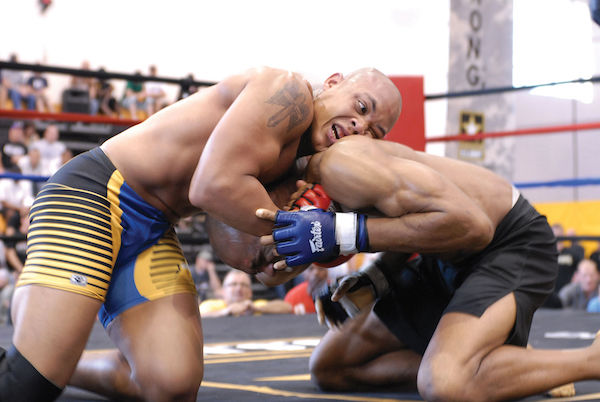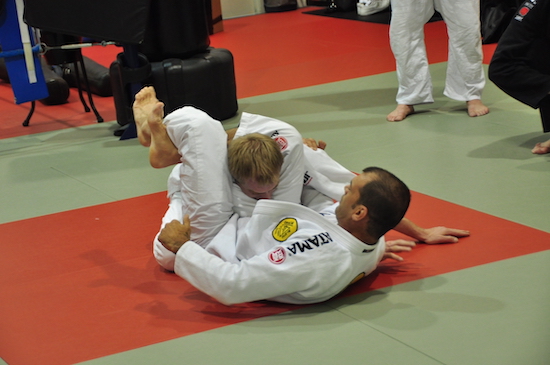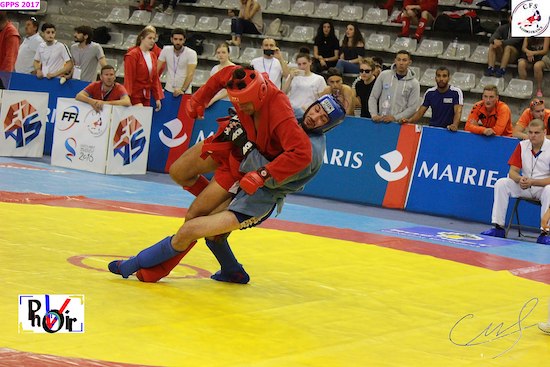
Are you wondering what the best grappling martial arts for success in MMA are?
In this article, we’ll explore the 3 best grappling martial arts for MMA by going through their strengths and weaknesses, as well as the UFC champions who’ve made them their base.
Contents
Best Grappling Martial Arts for MMA (Top 3)
In the dynamic world of mixed martial arts (MMA) and self-defense, grappling stands as a critical component, often dictating the outcome of a fight.
Grappling martial arts offer a diverse array of techniques for controlling an opponent, whether on the feet or on the ground, and they’re essential for any fighter looking to excel in the cage.
Starting with the most important, here are the best grappling martial arts for MMA success.
1. Wrestling

The narrative of wrestling’s dominance in MMA is rich with examples of fighters who have leveraged its principles to reach the pinnacle of the sport.
From Mark Coleman’s pioneering ground-and-pound strategy to the suffocating top control of Khabib Nurmagomedov, wrestling has been the common denominator in the success stories of numerous champions.
Here are the 3 common styles of wrestling practiced by MMA fighters:
1. Freestyle Wrestling: This Olympic wrestling style allows athletes to use their legs for both offense and defense. It’s known for its dynamic throws, takedowns, and ground control, focusing on pinning the opponent’s shoulders to the mat.
2. Greco-Roman Wrestling: Another Olympic style, Greco-Roman wrestling, prohibits holds below the waist, which encourages upper body strength, throws, and trips. This discipline enhances a fighter’s ability to control an opponent in the clinch.
3. Folkstyle Wrestling (Collegiate Wrestling): Predominant in the United States, folkstyle wrestling emphasizes control over the opponent. Points are awarded for controlling the opponent on the ground, making it highly applicable to MMA’s ground-and-pound strategies.
But what makes wrestling the best grappling martial art for MMA?
1. Mastery of Control and Ground-and-Pound
Mark Coleman, a formidable wrestler, popularized the term “ground-and-pound.” His strategy was consistent: secure a takedown, dominate on the ground, and then unleash a barrage of strikes.
This blueprint remains a proven formula for MMA success. Achieving takedowns and maintaining top control not only scores points and wins rounds but also sets the stage for a potential finish through ground and pound.
This dominance also effectively neutralizes an opponent’s Brazilian Jiu-Jitsu and striking, meaning damage received is limited.
2. The Ability to Dictate the Fight’s Direction
Superior wrestling skills in MMA grant the ability to steer the fight’s direction.
A proficient wrestler can press the action against the cage, engage in a clinch, bring it to the mat, or maintain a standing battle if they believe they have superior striking skills and much worse Brazilian jiu-jitsu.
As MMA has evolved, wrestling’s role has expanded, becoming integral for strikers to avoid takedowns and for grapplers to enforce their will.
If taken down, skilled wrestlers also have the ability to scramble back to their feet or at least minimize damage on the ground.
Against seasoned Brazilian Jiu-Jitsu competitors, a wrestler’s top position often forces defensive play, stalling their submission attempts.
3. Exhausting the Opponent
In the realm of MMA, cardiovascular endurance is paramount.
Wrestling excels in this aspect as it cultivates athletes capable of sustained high-intensity bursts through each five-minute round.
They most often have more strength, power, cardiovascular endurance, and muscular endurance, largely due to the rigorous demands of wrestling training.
Wrestlers engage in comprehensive conditioning that includes heavy and frequent weightlifting, which builds raw strength and explosive power.
The sport’s culture emphasizes pushing the limits of physical and mental toughness, resulting in athletes accustomed to enduring grueling workouts that far exceed the typical intensity found in other combat sports.
Ultimately, wrestlers can employ their craft to deplete an opponent’s energy reserves, controlling the fight’s tempo and securing victories by decision or by setting up a late finish through strikes or submissions.
4. Understanding and Experience with Weight Cutting
Wrestlers possess a nuanced understanding of weight management and weight cutting, a vital skill in a sport with strict weight classes.
Their background provides them with the know-how and experience to cut weight effectively, ensuring they enter the fight strong and energized.
This contrasts with many fighters who may suffer from the physical and mental toll of a draining weight cut.
While weight cutting carries inherent risks such as dehydration and decreased performance, wrestlers typically have the experience to mitigate these dangers, giving them an edge in MMA.
Overall
Wrestling is still the meta for MMA in 2023 because it’s required absolutely everywhere the fight goes.
The only exception arises in pure striking fights, yet even there, the inclusion of wrestling often tips the scales.
Wrestling’s influence is evident in the success of numerous UFC champions who have leveraged it to attain victory.
Notable UFC Champions with Wrestling Pedigrees:
- Khabib Nurmagomedov
- Islam Makhachev
- Randy Couture
- Aljamain Sterling
- Kamaru Usman
- Daniel Cormier
- Jon Jones
- Henry Cejudo
- Georges St-Pierre (GSP)
Challenges of Wrestling in MMA
Despite its strengths, wrestling is not without its drawbacks in MMA.
A singular focus on wrestling can lead to a lack of proficiency in joint locks and chokes, areas where judo and Brazilian Jiu-Jitsu excel.
Additionally, an overemphasis on wrestling can result in a passive approach, with fighters prioritizing position over submission, potentially leading to unfavorable decisions from the judges due to perceived inactivity.
2. Brazilian Jiu-Jitsu

The legacy of Brazilian jiu-jitsu (BJJ) in MMA is foundational, with its effectiveness showcased from the inception of modern mixed martial arts in the early 90s.
Royce Gracie’s victories in the earliest UFC tournaments illuminated the power of Bjj, as he, a lighter and seemingly less imposing figure, systematically submitted larger and more muscular opponents.
By winning the UFC 1, 2, and 4 tournaments, Royce Gracie cemented Bjj as a cornerstone grappling art for any serious MMA competitor.
But what makes Brazilian jiu-jitsu one of the best grappling martial arts for MMA?
1. Brazilian Jiu-Jitsu Wins Fights
Brazilian Jiu-jitsu is the secret weapon that can turn a losing fight around in an instant.
It’s all about submissions – those crafty techniques that force an opponent to tap out or risk injury.
Even if a fighter is behind, a well-timed submission like a choke or arm lock can snatch victory from the jaws of defeat.
Remember when Anderson Silva pulled off that surprise armbar against Chael Sonnen at UFC 117?
That’s why Brazilian jiu-jitsu is absolutely essential for success in MMA.
In the lighter weight classes where knockouts are rare, Bjj shines even brighter. It gives fighters a way to finish the fight when power is unable to do so.
And if you’re wondering about the judges, they love a good submission attempt. It can tip the scales in a close round, as long as the Bjj fighter hasn’t been getting dominated up to that point.
2. BJJ as a Defensive Lifeline
Defensively, Bjj serves as a shield, allowing fighters to mitigate damage from ground-and-pound tactics or to neutralize an opponent’s submissions.
It also offers a pipeline from defense to attack, enabling fighters to transition from a compromised position to one of control, either by securing a submission of their own or by maneuvering to a more advantageous position.
3. Technique Over Power: The BJJ Advantage
While MMA fighters compete in weight classes, minimizing disparities in size and strength, Bjj still offers a strategic edge through its emphasis on technique over brute force.
This principle is particularly beneficial for fighters who may not be the most muscular in their division.
Bjj teaches fighters to use leverage, timing, and anatomical knowledge to control and submit opponents.
This focus on skill rather than strength allows a fighter to conserve energy while causing opponents to exhaust themselves.
In the grueling rounds of an MMA fight, the ability to apply techniques effectively without relying on raw power can be the difference between victory and defeat.
Moreover, Bjj’s technical nature means it can be a great equalizer in fights where one competitor is naturally stronger.
A well-executed technique can neutralize the physical advantages of an opponent, making Bjj an essential tool for fighters who may lack knockout power but possess a cunning ground game.
The Evolution and Necessity of BJJ in MMA
As Bjj became an MMA staple, its surprise factor waned, with fighters across all levels gaining proficiency in ground fighting.
Yet, the absence of Bjj knowledge is a glaring vulnerability, often exploited by opponents who relentlessly pursue ground engagements to dominate or secure a submission. Thus, Bjj remains an indispensable art in the MMA arsenal.
BJJ’s strategic depth and proven track record of fight-finishing prowess secure its position as a top grappling art in MMA, essential for both offensive strategies and survival on the mat.
UFC Champions who used Bjj to win:
- Royce Gracie
- Fabricio Werdum
- Frank Mir
- Anderson Silva
- Charles Oliveira
- Glover Teixeira
- Islam Makhachev
Drawbacks of BJJ in MMA
While Bjj is a formidable grappling art, it isn’t without limitations within the MMA context.
Practitioners typically don’t train with strikes, which can be a disadvantage compared to combat sports like Sambo, where strikes are integrated.
Additionally, an overemphasis on securing submissions can lead to losing decisions if a fighter neglects to balance their grappling with effective striking and damage.
3. Combat Sambo

Combat sambo is a formidable Russian martial art that emerged in the 1920s as a comprehensive combat system – integrating striking, grappling, and submissions.
Developed by the Soviet Union’s Red Army and the NKVD, its primary goal was to mix the most effective techniques from a variety of martial arts into a singular, formidable discipline.
While it’s mostly considered a grappling martial art, combat sambo was designed to enhance the hand-to-hand combat skills of soldiers and has evolved into a dynamic and versatile martial art mirroring the multifaceted nature of MMA.
What makes combat sambo one of the best grappling martial arts for MMA?
1. Practitioners Learn Grappling With Striking Involved
Combat Sambo practitioners are trained to transition fluidly between striking and grappling, making it the perfect grappling martial art for MMA.
Wrestlers and Brazilian jiu-jitsu practitioners don’t have to worry about strikes when practicing takedowns, takedown defense, and grappling on the ground.
On the other hand, Combat Sambo practitioners learn to wrestle and grapple while strikes are in play.
They can defend strikes into takedowns and they have better timing in avoiding strikes and going for takedowns.
This integration prepares fighters for the realities of MMA, where strikes can come from any position at any time.
This awareness and skill are fundamental to success in MMA.
Combat Samboists can also seamlessly transition from ground control to submission attempts while under attack from strikes, whereas other grappling martial arts are practiced without this threat.
2. Explosive and Creative Throws and Takedowns
Combat Sambo incorporates a diverse range of explosive and creative throws and takedowns that draw from various martial arts, particularly judo, but also traditional folk wrestling styles and self-defense techniques.
Combat Sambo practitioners are especially known for their proficiency with leg grabs and leg locks, which are a significant part of their arsenal.
This includes a variety of ankle locks, kneebars, and heel hooks that can be applied from multiple positions.
Also, some Combat Sambo throws and takedowns are unique or are performed with variations not typically emphasized in wrestling or Brazilian Jiu-Jitsu.
Here are a few examples:
- Sacrifice Throws
- Foot Sweeps
- Hip Throws
- Suplexes
- Arm Drags to Takedowns
- Body Locks and Trips
- Scissor Takedowns
- Shoulder Throws
- Russian Tie Throws
Here’s a short video demonstrating the creativity and explosiveness of Sambo’s takedowns and throws:
Overall
Combat Sambo is one of the best grappling martial arts for MMA due to how it teaches practitioners to grapple while defending and mixing in strikes – a huge advantage over both wrestling and Brazilian jiu-jitsu.
They also learn how to transition from control to attacking submissions while under the threat of strikes.
Lastly, Combat Samboists learn a huge variety of explosive and creative throws and takedowns that aren’t commonly used. They can be used to surprise an opponent.
UFC Champions Well Versed in Combat Sambo
- Khabib Nurmagomedov
- Islam Makhachev
- Petr Yan
- Magomed Ankalaev
- Andrei Arlovski
Drawbacks of Combat Sambo in MMA
While it’s a strength, combat sambo’s integration of striking, grappling, and submissions can also be considered a drawback because of its lack of specialization.
However, the longer someone has trained in combat sambo, the less likely it’s a problem as all of their skills become elite and very well-rounded.
The Bottom Line
The 3 best grappling martial arts for MMA are wrestling, Brazilian jiu-jitsu, and combat sambo.
Wrestling is the cornerstone of MMA grappling, offering unmatched control and the ability to dictate the pace and position of the fight.
Its emphasis on top control, ground-and-pound, and endurance makes it a formidable base for any fighter. Drawbacks include potential passivity and a narrower focus on submissions.
Brazilian jiu-jitsu is the art of submission, providing fighters with the tools to secure victory from any position. It emphasizes technique and leverage, making it ideal for fighters of all sizes.
Its defensive capabilities are unparalleled, though it can lead to a focus on groundwork at the expense of striking and dealing damage.
Combat sambo combines the throws and takedowns of wrestling with the submissions of Bjj, all while integrating striking.
It creates well-rounded fighters prepared for all aspects of MMA combat. The drawback is its Jack-of-all-trades nature, which can dilute the focus on the finer points of each discipline.
In summary, these grappling arts are invaluable for MMA. They each have unique strengths that have worked in the octagon for many UFC champions who became elite in one of the above grappling martial arts.
The best fighters blend these styles to overcome the limitations of each and emerge as versatile, adaptable, and complete mixed martial artists.




